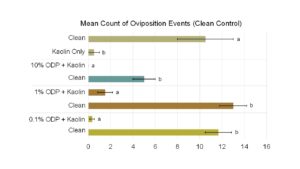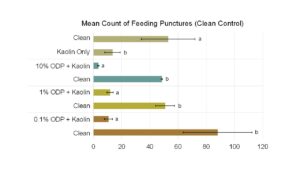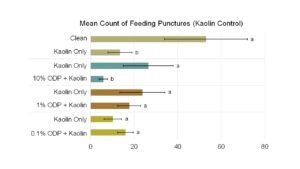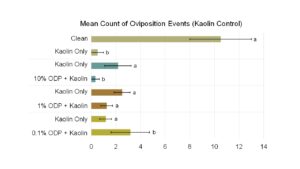Progress report for GS24-308
Project Information
The pepper weevil, Anthonomus eugenii Cano (Coleoptera: Curculionidae), is a devastating agricultural crop pest targeting peppers. Female weevils chew into a young pepper, oviposit, and cover the hole with a plug infused with an oviposition deterrent pheromone (ODP). Once infested, fruits are terminated by the plant, decreasing yield. Fruits that survive infestations or extensive feeding are often misshapen, further decreasing total crop yield. Current strategies focus on adult A. eugneii management using contact-based chemical insecticides and sanitization of crop debris, with limited management of immature stages protected by the pepper fruit. Chemical insecticides are economically expensive for growers, with harmful effects on the environment and human health. Sanitation of fields can be difficult as adult A. eugenii can survive off debris from pepper plants and many native Solanaceae present near the field, leading to re-infestation in the following season. Therefore, research into deterring initial oviposition is critically needed for future sustainable pest management strategies. Research suggests that using kaolin clay reduces oviposition and adult feeding on peppers. Similarly, young peppers treated with the ODP had 75% less oviposition than control peppers. Kaolin has adsorption capabilities for different types of volatiles and could allow a slow release of the pheromone. These strategies in combination have not been assessed; therefore, we hypothesize using kaolin clay mixed with the ODP to coat growing pepper, leading to decreased oviposition, decreased adult sightings, and increased total yield while reducing the dependence on harsh chemical sprays.
- Evaluation of different oviposition deterrent pheromone blends in greenhouse conditions
The oviposition deterrent pheromone (ODP) of A. eugenii was recently discovered and behavioral assays indicated A. eugenii females preferred clean peppers (without applied ODP) to peppers coated with ODP (Addesso et al., 2021). The study also found different ratios in the blend of semiochemicals comprising the ODP elicited similar responses when compared to clean, uninfested peppers but did not compare the different ratio blends to one another.
This experiment is designed to compare the different ratio blends of the ODP: 1) 1 mL linoleic acid with 1 µL acetophenone; 2) 6:3:1 (oleic, linoleic, and linolenic acid) with 10% acetophenone; 3) 6:3:1 (oleic, linoleic, and linolenic acid) with 10% acetophenone and 20% stearic acid; 4) Pentane solvent control. Stearic acid creates a “semi-solid” solution to mimic an oviposition plug. If behavioral responses to the blends are not different the simplest blend will be utilized for Objectives 2 and 3.
- Evaluate the response of female eugenii with previous experience with the oviposition deterrent pheromone
A single, female A. eugenii from a mixed colony to ensure she has been mated will be placed inside a 5 cm tall glass sample vial with 0.5 mL of the ODP found to be the most deterrent (Objective 1). Female A. eugenii will be exposed to the ODP or solvent control for 24 h, 48 h or 72 h. The vials with the ODP and weevil will be placed on an automatic slow-roller to evenly spread the solution. The female will then be placed into a plastic container with 5 ODP treated peppers 24 h. After this time has passed, the number of oviposition sites will be counted.
This experiment is designed to evaluate the response of female A. eugenii with different levels of experience to the ODP. The response in this experiment will be the number of oviposition sites found on the peppers of the females from different exposure times.
- Field evaluation of ODP combined with kaolin clay to prevent eugenii infestation.
The ODP blend that reduces oviposition, adult feeding, and fruit drop the most will be used in the field evaluation with kaolin clay. Treatments to be evaluated will be 1) ODP singularly; 2) Kaolin singularly; 3) ODP infused into kaolin; 4) Insecticide treatment (Thiamethoxam and oxamyl rotation); and 5) Untreated control.
This experiment is designed to assess the integrated method compared to the different components (ODP and kaolin) singularly.
Cooperators
- (Researcher)
Research
- Evaluation of different oviposition deterrent pheromone blends in greenhouse conditions
Addesso et al. (2021) previously identified the blend of compounds found in the oviposition deterrent pheromone (ODP) for A. eugenii through analyses with gas chromatography coupled with mass spectrometry (GC-MS). The semiochemical blend present in the oviposition plugs was found to be a combination of acetophenone, oleic, linoleic, and linolenic acid. Additional GC-MS analyses determined the relative ratios of the fatty acids present with acetophenone (Addesso et al., 2021). The different ratio blends of the ODP were tested against clean peppers (no ODP and without any weevil contact) but were not tested against each other. In this project, the different ratio blends of the ODP will be tested against one another in greenhouse setting to determine the best blend to be used in future studies. Management programs using organic strategies to target greenhouse pests like A. eugenii are critically needed in peppers due to their status as the second largest vegetable commodity produced in this specific environment (Fernández et al., 2020).
The greenhouse trial will be conducted at the UF/IFAS NFREC (Quincy, FL). Jalapeno pepper plants will be grown from seed and subjected to different semiochemical blend applications when 95% of the plants are producing flowers and fruits with 1 cm length. Fifty A. eugenii adults from the laboratory rearing will be released into the greenhouse in the front, middle, and rear positions to infest jalapeno fruits for two months.
ODP blends to be evaluated in greenhouse settings from previous literature will be: 1) 1 mL linoleic acid with 1 μL acetophenone; 2) 6:3:1 (oleic, linoleic, and linolenic acid) with 10% acetophenone; 3) 6:3:1 (oleic, linoleic, and linolenic acid) with 10% acetophenone and 20% stearic acid; 4) Pentane solvent dissolved in water control. Each treatment will have 6 replicates with 5 plants each. Pheromone blends will be sprayed onto the plants weekly. Collection days will occur once prior to a subsequent treatment application. Data to be collected weekly will be puncture hole counts, oviposition sites of subsampled peppers, total dropped peppers, and yield at the end of the trial.
- Evaluate the response of female eugenii with previous experience with the oviposition deterrent pheromone.
The oviposition deterrent blend used in this experiment will be the most deterring of the preceding greenhouse trial. Female A. eugenii adults of ages 5 – 20 days old will be used during this experiment. The inside of a glass microcentrifuge tube will be coated in 0.5 mL of the pheromone dissolved in stearic acid after which a single, female weevil will be added.
The weevil will be held inside the microcentrifuge tube for 24 h, 48 h, or 72 h. The vials with the ODP and weevil will be placed on an automatic slow-roller to evenly spread the solution. After the exposure time has ended, the female weevil will be added to a plastic dish with 5 pheromone treated pepper for 24 hours. At the end of 24 h, the weevil will be removed, and number of oviposition plugs will be counted. There will be 20 replicates for each time exposure treatments.
- Field evaluation of ODP combined with kaolin clay to prevent eugenii infestation.
Two field trials will occur at the NFREC (Quincy, FL) site during the spring and fall cropping seasons, one per season. Five treatments will be evaluated: 1: Kaolin clay with semiochemical blend; 2) Kaolin clay alone; 3) Semiochemical blend alone; 4) Pesticide treatment (Thiamethoxam and oxamyl rotation); 5) Untreated control (water). Based on the preceding greenhouse behavioral trials, the most effective semiochemical blend mimicking the oviposition plug will be created with rates previously described (Addesso et al., 2021). Four rows will contain 60 plants each, 10 plants per treatment, with 6 replicates per each season. Collection days will occur once prior to a subsequent treatment application. Data to be collected weekly will be puncture hole counts, oviposition sites of the subsampled peppers, number of adults visually present in each treatment, total number of dropped peppers in each treatment, and yield at the end of the trial.
During the ODP-kaolin solution phytotoxicity trials, no leaf burning was visually detected. Leaves previously treated with an ODP-kaolin solution that were rinsed were visually compared to leaves treated with a distilled water spray. No leaves from the experimental plants were dropped prematurely. None of the ODP-kaolin treatments were found to cause burning or any abnormalities in the flowers.
Evaluations and replications of the different concentrations of the ODP-kaolin clay treatments against kaolin clay only or clean peppers are still in progress. Data presented here are current results based on preliminary data. Preliminary data suggests female A. eugenii prefer to oviposit on clean peppers compared to kaolin only and ODP-kaolin treated jalapeño peppers (Figure 1). Similarly, females show a preference to feed on clean peppers compared to jalapeño peppers treated with kaolin only or an ODP-kaolin treatment (figure 2).


Preliminary data suggests female A. eugenii show preference to oviposit in kaolin only treated jalapeño peppers compared to the 10% ODP-kaolin clay treatment (Figure 3). Females currently do not show an oviposition or feeding preference between kaolin-only treated jalapeño peppers compared to the 1% ODP-kaolin clay treatment (Figure 4). When comparing kaolin-only treated jalapeño peppers to the 0.1% ODP-kaolin clay treatment, females currently show an increased preference for the ODP-kaolin clay treatment.


Educational & Outreach Activities
Participation summary:
Pepper field day, UF/IFAS, October 23 2024, at Citra, FL
The student made the presentation in front of 100 growers and agricultural professionals.
Project Outcomes
Currently, our research indicates preliminary evidence of the pepper weevil's oviposition deterrent pheromone (ODP) in combination with kaolin clay has a synergistic deterrent effect compared to control (untreated) peppers or kaolin clay only treated peppers. Our preliminary data suggests the potential use of the ODP + kaolin clay spray as another potential tool for growers to use or add to their current pest management strategies specifically to reduce the use of broad-spectrum, contact based insecticidal sprays.
My knowledge and awareness of sustainable agriculture positively increased. I've learned new skills, specifically about proper applications of certain organic pest management strategies, such as kaolin clay, and how I can better use them to achieve different growers' expected results. Both my advisor and I have high views of sustainable agriculture. This project has further strengthened these views and will continue to grow as the project continues.
As of today, we believe that surround (kaolin clay) applied at the recommended rate of 25 lbs/Acre could help reduce pepper weevil. It could be used in addition to actual insecticide treatments.